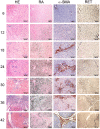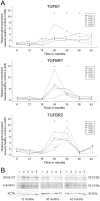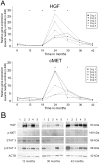COMMD1-deficient dogs accumulate copper in hepatocytes and provide a good model for chronic hepatitis and fibrosis
- PMID: 22879914
- PMCID: PMC3412840
- DOI: 10.1371/journal.pone.0042158
COMMD1-deficient dogs accumulate copper in hepatocytes and provide a good model for chronic hepatitis and fibrosis
Abstract
New therapeutic concepts developed in rodent models should ideally be evaluated in large animal models prior to human clinical application. COMMD1-deficiency in dogs leads to hepatic copper accumulation and chronic hepatitis representing a Wilson's disease like phenotype. Detailed understanding of the pathogenesis and time course of this animal model is required to test its feasibility as a large animal model for chronic hepatitis. In addition to mouse models, true longitudinal studies are possible due to the size of these dogs permitting detailed analysis of the sequence of events from initial insult to final cirrhosis. Therefore, liver biopsies were taken each half year from five new born COMMD1-deficient dogs over a period of 42 months. Biopsies were used for H&E, reticulin, and rubeanic acid (copper) staining. Immunohistochemistry was performed on hepatic stellate cell (HSC) activation marker (alpha-smooth muscle actin, α-SMA), proliferation (Ki67), apoptosis (caspase-3), and bile duct and liver progenitor cell (LPC) markers keratin (K) 19 and 7. Quantitative RT-PCR and Western Blots were performed on gene products involved in the regenerative and fibrotic pathways. Maximum copper accumulation was reached at 12 months of age, which coincided with the first signs of hepatitis. HSCs were activated (α-SMA) from 18 months onwards, with increasing reticulin deposition and hepatocytic proliferation in later stages. Hepatitis and caspase-3 activity (first noticed at 18 months) increased over time. Both HGF and TGF-β1 gene expression peaked at 24 months, and thereafter decreased gradually. Both STAT3 and c-MET showed an increased time-dependent activation. Smad2/3 phosphorylation, indicative for fibrogenesis, was present at all time-points. COMMD1-deficient dogs develop chronic liver disease and cirrhosis comparable to human chronic hepatitis, although at much higher pace. Therefore they represent a genetically-defined large animal model to test clinical applicability of new therapeutics developed in rodent models.
Conflict of interest statement
Figures



Similar articles
-
Aberrant expression of copper associated genes after copper accumulation in COMMD1-deficient dogs.J Trace Elem Med Biol. 2015 Jan;29:347-53. doi: 10.1016/j.jtemb.2014.06.007. Epub 2014 Jun 24. J Trace Elem Med Biol. 2015. PMID: 25053573
-
Copper-induced hepatitis: the COMMD1 deficient dog as a translational animal model for human chronic hepatitis.Vet Q. 2011 Mar;31(1):49-60. doi: 10.1080/01652176.2011.563146. Vet Q. 2011. PMID: 22029820 Review.
-
c-Met confers protection against chronic liver tissue damage and fibrosis progression after bile duct ligation in mice.Gastroenterology. 2009 Jul;137(1):297-308, 308.e1-4. doi: 10.1053/j.gastro.2009.01.068. Epub 2009 Feb 5. Gastroenterology. 2009. PMID: 19208365
-
Physalin D attenuates hepatic stellate cell activation and liver fibrosis by blocking TGF-β/Smad and YAP signaling.Phytomedicine. 2020 Nov;78:153294. doi: 10.1016/j.phymed.2020.153294. Epub 2020 Jul 28. Phytomedicine. 2020. PMID: 32771890
-
Functional understanding of the versatile protein copper metabolism MURR1 domain 1 (COMMD1) in copper homeostasis.Ann N Y Acad Sci. 2014 May;1314:6-14. doi: 10.1111/nyas.12353. Epub 2014 Feb 12. Ann N Y Acad Sci. 2014. PMID: 24697840 Review.
Cited by
-
COMMD1 Exemplifies the Power of Inbred Dogs to Dissect Genetic Causes of Rare Copper-Related Disorders.Animals (Basel). 2021 Feb 25;11(3):601. doi: 10.3390/ani11030601. Animals (Basel). 2021. PMID: 33668783 Free PMC article. Review.
-
Therapeutic implications of impaired nuclear receptor function and dysregulated metabolism in Wilson's disease.Pharmacol Ther. 2023 Nov;251:108529. doi: 10.1016/j.pharmthera.2023.108529. Epub 2023 Sep 22. Pharmacol Ther. 2023. PMID: 37741465 Free PMC article. Review.
-
Gene expression patterns in the progression of canine copper-associated chronic hepatitis.PLoS One. 2017 May 1;12(5):e0176826. doi: 10.1371/journal.pone.0176826. eCollection 2017. PLoS One. 2017. PMID: 28459846 Free PMC article.
-
Elucidating the dynamic tumor microenvironment through deep transcriptomic analysis and therapeutic implication of MRE11 expression patterns in hepatocellular carcinoma.Cancer Cell Int. 2025 Aug 21;25(1):311. doi: 10.1186/s12935-025-03931-7. Cancer Cell Int. 2025. PMID: 40841647 Free PMC article.
-
CCC- and WASH-mediated endosomal sorting of LDLR is required for normal clearance of circulating LDL.Nat Commun. 2016 Mar 11;7:10961. doi: 10.1038/ncomms10961. Nat Commun. 2016. PMID: 26965651 Free PMC article.
References
-
- Henderson NC, Forbes SJ (2008) Hepatic fibrogenesis: From within and outwith. Toxicology 254: 130–135. - PubMed
-
- Cassiman D, Libbrecht L, Desmet V, Denef C, Roskams T (2002) Hepatic stellate cell/myofibroblast subpopulations in fibrotic human and rat livers. J Hepatol 36: 200–209. - PubMed
-
- Bedossa P, Paradis V (2003) Liver extracellular matrix in health and disease. J Pathol 200: 504–515. - PubMed
-
- Mekonnen GA, IJzer J, Nederbragt H (2007) Tenascin-C in chronic canine hepatitis : immunohistochemical localization and correlation with necro-inflammatory activity, fibrotic stage, and expression of alpha-smooth muscle actin, cytokeratin 7, and CD3+ cells. Vet Pathol 44: 803–813. - PubMed
MeSH terms
Substances
LinkOut - more resources
Full Text Sources
Medical
Research Materials
Miscellaneous

